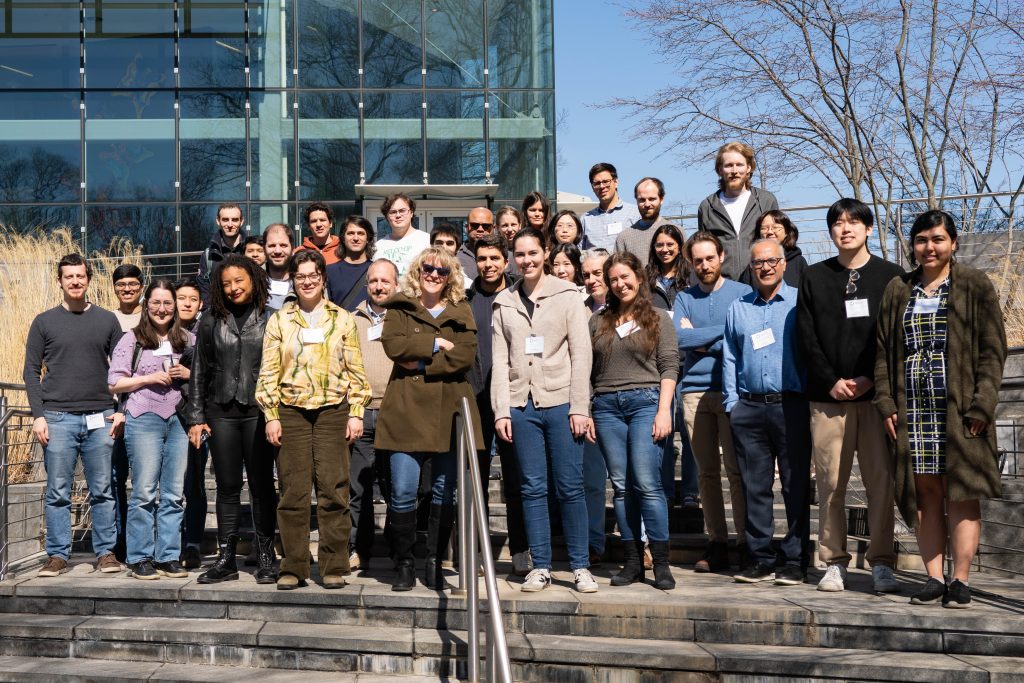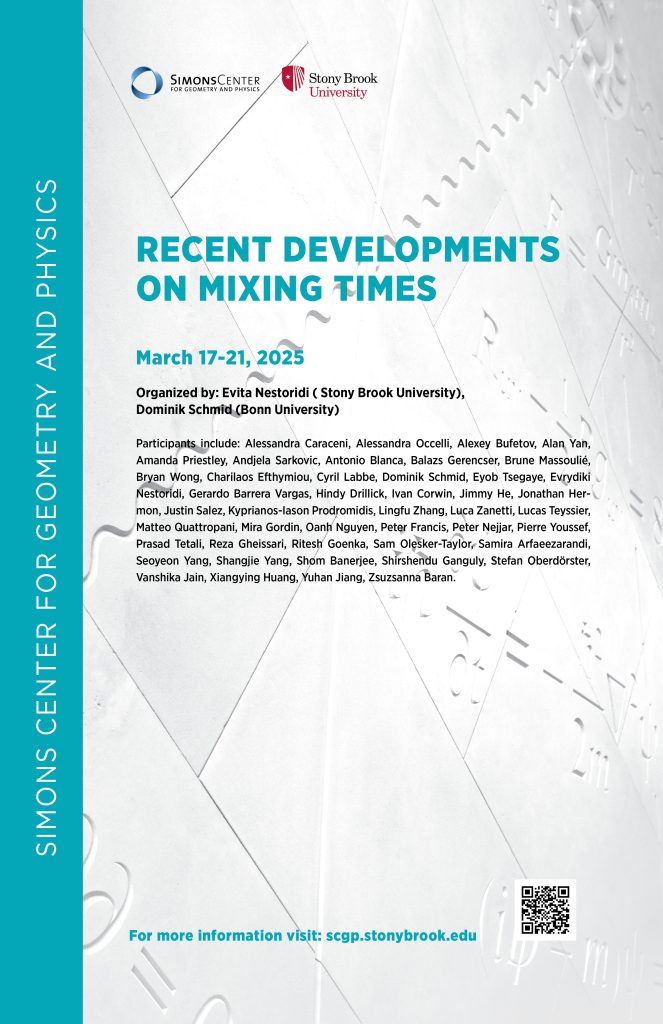Participant ListScheduleView Videos
Organized by:
- Evita Nestoridi ( Stony Brook University)
- Dominik Schmid ( Bonn University)
Markov chains serve as indispensable tools for generating random structures, such as graph colorings, vector space bases, and polygon triangulations. Mixing times capture the temporal evolution towards equilibrium. Of particular interest is the abrupt transition from unmixed to mixed – the cutoff phenomenon. The cutoff phenomenon was first discovered by Diaconis and Shashahani in the context of card shuffling. Many techniques from representation theory, combinatorics and probability, comparison theory, Nash inequalities, evolving sets, distinguishing statistics, and many more have been developed to understand mixing times. The question whether cutoff occurs was solved over the years for many models, for example random walks on random graphs, the card shuffles, or the east process. In recent years, many new techniques to verify the occurrence or absence of cutoff, as well as even more refined results on the convergence towards the stationary distribution, were established.
Our main goal is to bring together people with backgrounds from mathematical physics, probability theory and theoretical computer science, and develop new insights on mixing times. In particular, the interplay between the exciting new methods from recent years including information percolation, stochastic localization, and varentropy methods is promising towards improving the understanding of cutoff. Another goal is to strengthen the research on limit profiles, which are an exciting new objective in the study of mixing times for Markov chains.

Talk Schedule
| Time | Title | Speaker | Location |
| 8:30am | Breakfast | N/A | SCGP Cafe |
| 9:30am | Ergodicity, mixing and classification of Gibbs states for area-tilted Brownian lines | Shirshendu Ganguly | SCGP 102 |
| 10:30am | Coffee Break | N/A | SCGP Cafe |
| 11:00am | Phase ordering for the Ising dynamics on random regular graphs | Reza Gheissari | N/A |
| 12:00pm | Lunch | N/A | SCGP Cafe |
| 1:30pm | Cutoff of the Repeated Averaging Process on Graphs | Lingfu Zhang | SCGP 102 |
| 2:30pm | 1) k-star transposition shuffle, 2) Mixing Time and Cutoff for the Capacity k Symmetric Partial Exclusion Process, 3) Cutoff and Dynamical Phase Transition for the General Multi-componentIsing Model | 1) Samira Arfaee, 2) Eyob Tsegaye, 3) Seoyeon Yang | SCGP 102 |
| 3:30pm | Tea Time | N/A | SCGP Cafe |
| 4:00pm | 1) Cutoff for a generalized Bernoulli-Laplace model, 2) Vector-Valued Concentration & Random Walks on Groups, 3) The doubly asymmetric simplex exclusion process | 1) Ritesh Goenka, 2) Mira Gordin, 3) Yuhan Jiang | SCGP 102 |
| Time | Title | Speaker | Location |
| 8:30am | Breakfast | N/A | SCGP Cafe |
| 9:30am | Cutoff phenomenon in nonlinear recombinations | Cyril Labbe | SCGP 102 |
| 10:30am | Coffee Break | N/A | SCGP Cafe |
| 11:00am | Cutoff for random walks on nilpotent groups | Jonathan Hermon | SCGP 102 |
| 12:00pm | Lunch | N/A | SCGP Cafe |
| 1:30pm | Cutoff phenomenon for the ergodic CIR process and extensions | Gerardo Barrera | SCGP 102 |
| 2:30pm | 1) Cutoff for the mixing time of the Facilitated Exclusion Process and the Symmetric, 2) Mixing of a random walk on a randomly twisted hypercube Exclusion Process with Traps, 3)Mixing of a random walk on a randomly twisted hypercube | 1) Brune Massoulie, 2) Zsuzsanna Baran, 3) Andjela Sarkovic | SCGP 102 |
| 3:30pm | Tea Time | N/A | SCGP Cafe |
| 4:00pm | 1) Cutoff for the Biased Random Transposition Shuffle, 2) A probabilistic parking process and labeled IDLA, 3) Accelerated Mixing in Markov chain Monte Carlo | 1) Alan Yan, 2) Amanda Priestley, 3) Stefan Oberdorster | N/A |
| Time | Title | Speaker | Location |
| 8:30am | Breakfast | N/A | SCGP Cafe |
| 9:30am | Regularized functional inequalities, discrete curvature, and applications to Markov chains | Pierre Youssef | SCGP 102 |
| 10:30am | Coffee Break | N/A | SCGP Cafe |
| 11:00am | Cutoff for Cayley Graphs of Nilpotent Groups | Xiangying (Zoe) Huang | SCGP 102 |
| 12:00pm | Lunch | N/A | SCGP Cafe |
| 11:45am | Group Photo | N/A | SCGP Lobby |
| 1:30pm | Curvature and concentration in time-inhomogeneous Markov chains, | Luca Zanetti | SCGP 102 |
| 2:30pm | Simultaneous cutoff for Markov chains on the multitype configuration model | Balazs Gerencser | N/A |
| 3:30pm | Tea Time | N/A | SCGP Cafe |
| 4:00pm | Cutoff profiles for conjugacy invariant walks on symmetric groups | Lucas Teyssier | SCGP 102 |
| 4:40pm | Limit profiles of ASEP | Peter Neijar | SCGP 102 |
| 6:00pm | Banquet Dinner | N/A | SCGP Cafe |
| Time | Title | Speaker | Location |
| 8:30am | Breakfast | N/A | SCGP Cafe |
| 9:30am | Sampling from the Potts model at low temperatures via random-cluster dynamics | Antonio Blanca | SCGP 102 |
| 10:30am | Coffee Break | N/A | SCGP Cafe |
| 11:00am | On sampling two spin models using the local connective constant | Charis Efthymiou | SCGP 102 |
| 12:00pm | Lunch | N/A | SCGP Cafe |
| 1:30pm | Dynamics of Epidemics on Random Graphs | Oanh Nguyen | SCGP 102 |
| 2:30pm | A Randomised Approach to Sorting | Sam Olesker-Taylor | SCGP 102 |
| 3:10pm | Mixing Time of the Glauber Dynamics for the Critical Ising Model on Sparse Graphs | Kyprianos Iason-Prodomidis | SCGP 102 |
| 3:30pm | Tea Time | N/A | SCGP Cafe |
| Time | Title | Speaker | Location |
| 8:30am | Breakfast | N/A | SCGP Cafe |
| 9:30am | Cutoff profile for the ASEP with one open boundary | Jimmy He | SCGP 102 |
| 10:30am | Coffee Break | N/A | SCGP Cafe |
| 11:00am | An information-differential approach to cutoff | Justin Salez | SCGP 102 |
| 12:00pm | Lunch | N/A | SCGP Cafe |
| 3:30pm | Tea Time | N/A | SCGP Cafe |


